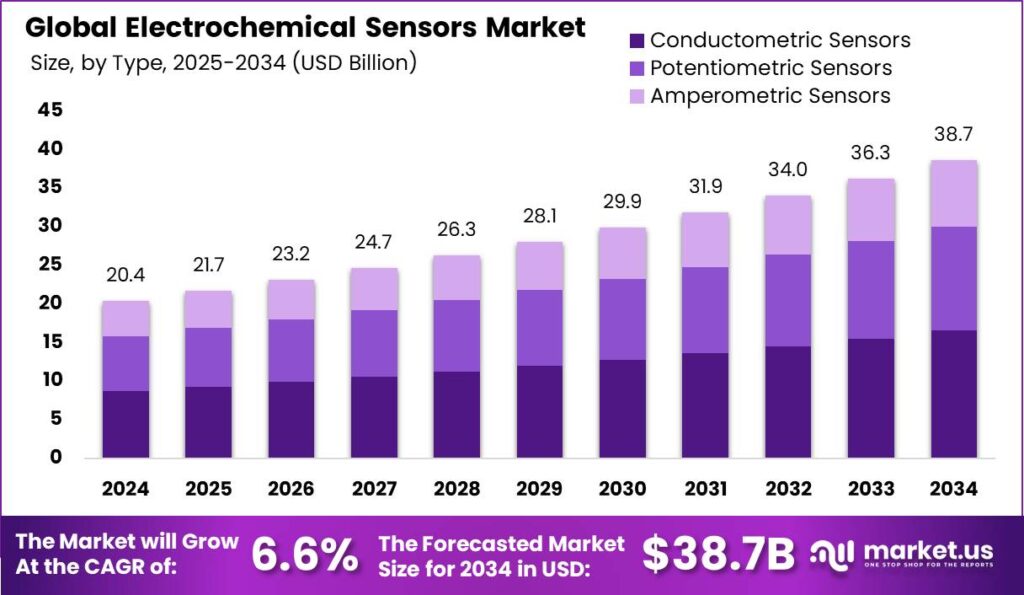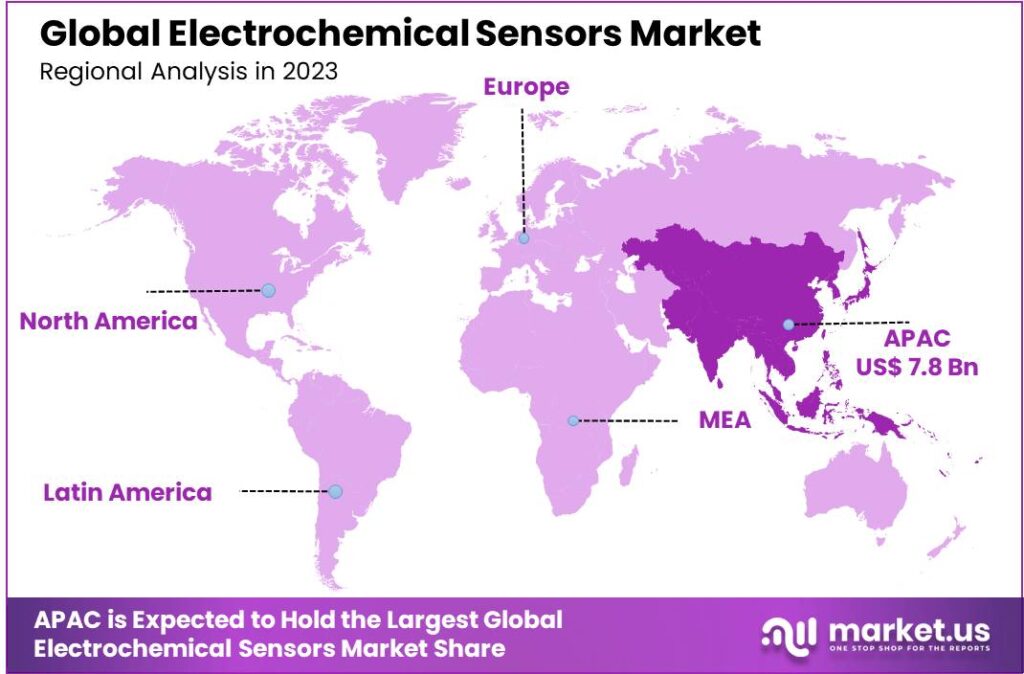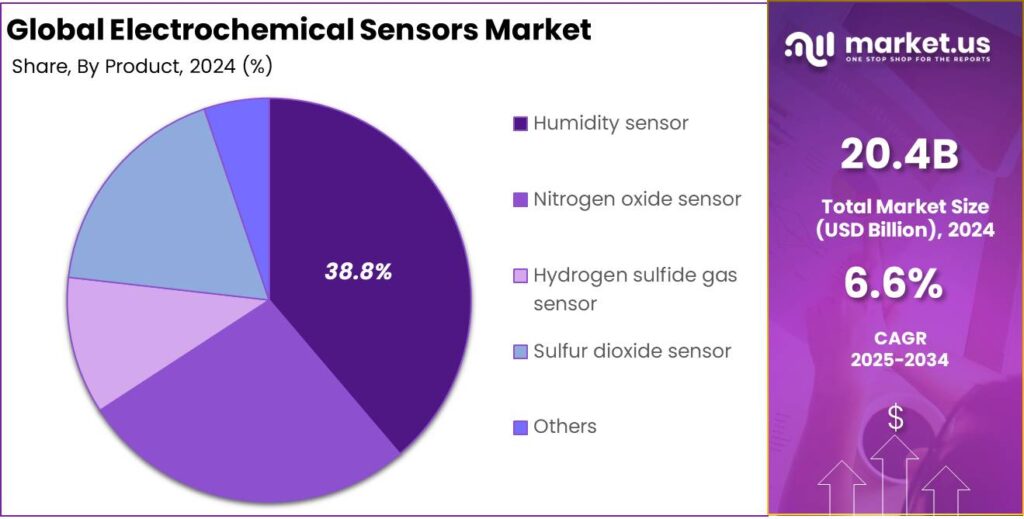Table of Contents
Report Overview
According to Market.us, The Global Electrochemical Sensors Market is projected to reach a value of USD 38.7 billion by 2034, up from USD 20.4 billion in 2024, reflecting a robust compound annual growth rate (CAGR) of 6.60% from 2025 to 2034. In 2024, the Asia-Pacific (APAC) region dominated the market, holding a significant 38.5% share and generating USD 7.8 billion in revenue. A major driving force behind this growth was China, where the electrochemical sensors market alone was valued at USD 3.0 billion.
Electrochemical sensors are integral to modern analytical chemistry, transforming chemical data into analytically usable signals. These devices typically consist of a receptor and a transducer, where the receptor interacts with a target analyte and the transducer converts this interaction into a measurable signal. This dual-component setup allows for high specificity and accurate detection across various applications, from environmental monitoring to healthcare.
The growth of electrochemical sensors is driven by their ability to provide precise, low-cost, and rapid analysis, which is essential in numerous sectors such as healthcare, environmental monitoring, and industrial processing. Advances in miniaturization and microfabrication have significantly enhanced the sensitivity and selectivity of these sensors, making them more appealing for in-situ and real-time analyses. The growing need for efficient and sustainable practices, especially in agriculture and environmental monitoring, further propels their adoption.
Electrochemical sensors have a broad range of applications. In environmental science, they are crucial for detecting pollutants in situ, allowing for immediate and accurate monitoring of environmental health. In healthcare, they are used for monitoring glucose levels in diabetic patients and detecting biomarkers in various diseases. Their versatility also extends to industrial applications where they are employed in quality control and safety monitoring.

Despite their advantages, electrochemical sensors face significant challenges. One of the main issues is the interference from other chemical species which can lead to false readings. The development of sensors that can operate effectively in complex matrices, such as blood or industrial effluents, is still a major area of research. Additionally, ensuring long-term stability and repeatability in diverse environmental conditions continues to be a challenge.
Technological advancements are continually shaping the field of electrochemical sensors. Innovations include the development of nanomaterial-based sensors, which offer enhanced sensitivity and specificity, and the integration of digital technologies for data analysis and remote monitoring. These innovations not only improve the performance of the sensors but also extend their applicability across different domains.
The market for electrochemical sensors is expanding due to the increasing awareness of health and environmental issues, which drives the demand for more rigorous monitoring systems. The integration of IoT (Internet of Things) capabilities with electrochemical devices is also opening new avenues for growth, facilitating the development of smart, connected devices that can provide insights into health and environmental conditions in real time.
Key Takeaways
- In 2024, the Conductometric Sensors segment was the market leader, accounting for more than 42.8% of the total market share.
- The Humidity Sensor segment also secured a strong position, representing over 38.8% of the market share.
- The Healthcare & Pharmaceuticals sector was the largest end-user, contributing to more than 26.4% of the overall electrochemical sensors market in 2024.
- The Asia-Pacific region dominated the market, capturing more than 38.5% of the global share, with total revenues reaching USD 7.8 billion.
- Specifically, the China Electrochemical Sensors Market was valued at USD 3.0 billion in 2024, highlighting its substantial role in the regional market.
Impact Of AI
- Enhanced Sensitivity and Accuracy: AI algorithms process complex data from sensors, improving their ability to detect substances with greater sensitivity and accuracy. This advancement leads to more reliable measurements in various applications.
- Improved Data Analysis: By applying machine learning techniques, AI helps in analyzing intricate electrochemical data, enabling better interpretation and extraction of meaningful information. This process enhances the overall performance of sensors.
- Real-time Monitoring: AI enables electrochemical sensors to monitor multiple components simultaneously in real-time. This capability is particularly beneficial in complex biological analyses, improving efficiency and performance.
- Optimization of Sensor Design: Through AI-driven experimental designs, the fabrication and optimization of electrochemical sensors are systematically improved. This approach considers the effects of individual variables and their interactions, leading to better sensor performance.
- Overcoming Analytical Challenges: AI assists in addressing common issues in electrochemical sensing, such as electrode fouling and chemical interferences. By leveraging machine learning models, sensors can achieve accurate analyses even in challenging conditions.
Regional Analysis
In 2024, the Asia-Pacific (APAC) region emerged as a leader in the global Electrochemical Sensors Market, holding a substantial 38.5% share and generating impressive revenues of USD 7.8 billion. This dominant performance can be largely attributed to significant contributions from various countries within the region, with China playing a pivotal role. The Chinese market specifically excelled in the Electrochemical Sensors sector, where it was valued at US$ 3.0 billion. This valuation underscores China’s critical influence and its capacity to drive regional market trends within APAC.
The robust market share held by the APAC region is reflective of broader economic trends and the strategic emphasis placed on technological advancements in these countries. Electrochemical sensors, which are vital for a myriad of applications including environmental monitoring, healthcare, and industrial processes, have seen rapid adoption due to their accuracy and reliability. China’s substantial contribution to this sector highlights its investment in research and development, as well as its growing expertise in high-tech industries. This focus not only enhances China’s economic landscape but also positions APAC as a formidable force in the global market for advanced technologies.

Market Segmentation
Type Analysis
In 2024, the Conductometric Sensors segment led the electrochemical sensors market, capturing over 42.8% of the total market share. These sensors are widely used for detecting changes in electrical conductivity, which can be indicative of the presence of certain chemicals or pollutants. Their ability to deliver real-time, accurate measurements makes them ideal for industrial applications, water quality monitoring, and environmental testing. The increasing demand for process control and the need for efficient monitoring in industries like manufacturing and water treatment contributed to the segment’s dominance.
Product Analysis
The Humidity Sensor segment also held a significant position in the electrochemical sensors market in 2024, accounting for more than 38.8% of the market share. Humidity sensors are essential for measuring moisture levels in various environments, from industrial applications to healthcare and agriculture. These sensors are increasingly being adopted in consumer electronics, HVAC systems, and industrial process control, where precise humidity measurement is critical. Their role in maintaining optimal conditions for both manufacturing processes and indoor environments has driven the growth of this segment.

End-User Analysis
The Healthcare & Pharmaceuticals segment was the largest vertical in the electrochemical sensors market in 2024, with over 26.4% market share. Electrochemical sensors are vital in medical diagnostics, patient monitoring systems, and drug development, as they enable real-time detection of biomarkers, glucose levels, and other vital signs. The growing demand for point-of-care devices, wearable health monitors, and non-invasive diagnostic tools, coupled with the ongoing advancements in medical technology, has driven the significant adoption of electrochemical sensors in the healthcare sector. This trend is expected to continue as the need for efficient, cost-effective healthcare solutions rises globally.
Emerging Trends
- Integration of Machine Learning: Combining machine learning with electrochemical sensing enhances the detection of multiple substances simultaneously. This approach improves the accuracy and efficiency of sensors in analyzing complex biological samples.
- Advancements in Flexible and Wearable Sensors: The development of flexible materials, such as carbon nanotubes, has led to the creation of wearable electrochemical sensors. These devices are lightweight and portable, making them suitable for continuous health monitoring and robotic applications.
- Miniaturization for On-Site Detection: Miniaturized electrochemical sensors, including those based on screen-printed and paper-based electrodes, offer cost-effective and rapid analysis. They require smaller sample volumes and are effective for on-site detection of environmental pollutants.
- Use of Laser-Derived Graphene: Employing laser-derived graphene in sensor fabrication enhances electrochemical performance. This method improves sensitivity and selectivity in detecting various biomolecules, contributing to more efficient and cost-effective sensor production.
- Development of Wearable Biosensors for Telehealth: Emerging materials and technologies are enabling the creation of wearable sensors for telehealth applications. These devices can monitor physiological signals, such as body temperature and heart rate, providing real-time health data for remote medical assessments.
Top Use Cases
- Medical Diagnostics: Electrochemical sensors are widely used in medical diagnostics, particularly for monitoring blood glucose levels in diabetic patients. These sensors provide rapid and accurate measurements, enabling effective disease management.
- Environmental Monitoring: These sensors play a crucial role in detecting pollutants, such as heavy metals in water sources. By providing real-time data on contamination levels, they help in assessing and maintaining environmental health.
- Industrial Safety: In industrial settings, electrochemical sensors are employed to detect hazardous gases like carbon monoxide. Their ability to provide immediate alerts ensures worker safety and prevents potential accidents.
- Food Quality Control: These sensors are utilized in the food industry to monitor freshness and detect contaminants. For instance, they can measure the levels of certain chemicals to ensure the safety and quality of food products.
- Wearable Health Monitors: Advancements in electrochemical sensor technology have led to their integration into wearable devices. These devices can continuously monitor physiological parameters, providing valuable health data for personal and clinical use.
Major Challenges
- Limited Temperature Range: These sensors operate effectively only within a narrow temperature band. Significant temperature fluctuations can impair their accuracy and reliability.
- Short Shelf Life: Typically, electrochemical sensors have a shelf life ranging from six months to a year. This limited lifespan necessitates frequent replacements, increasing maintenance costs.
- Cross-Sensitivity to Other Gases: While designed to detect specific gases, these sensors can be affected by the presence of other gases. This cross-sensitivity may lead to inaccurate readings and false alarms.
- Aging and Sensitivity Drift: Over time, sensor sensitivity can drift by up to 20% per year. This aging effect compromises long-term performance and measurement accuracy.
- Environmental Susceptibility: Factors such as humidity, pressure, and the presence of corrosive elements can adversely affect sensor performance. Exposure to harsh environments may lead to sensor degradation or failure.
Market Opportunities for Key Players
- Healthcare and Diagnostics: There is a substantial demand for electrochemical sensors in healthcare, particularly for point-of-care diagnostics and patient monitoring. This is underscored by the integration of biosensors in medical equipment and the rapid growth of diagnostics that require real-time analysis and monitoring. The development of electrochemical sensors for COVID-19 diagnostics and other viral infections has highlighted their importance in healthcare.
- Environmental Monitoring: Electrochemical sensors are increasingly used for air quality monitoring and environmental protection. The need for accurate and reliable monitoring of air pollutants drives the demand for these sensors, especially in urban and industrial settings. This trend is expected to continue as cities globally strive to improve air quality and reduce environmental impact.
- Industrial Safety: In industries where exposure to toxic gases is a risk, such as chemical and oil and gas sectors, there is a growing use of electrochemical sensors for safety monitoring. Strict regulations and the need for effective safety measures boost the demand for these sensors, which are critical for preventing industrial accidents and ensuring workplace safety.
- Automotive Applications: The automotive industry utilizes electrochemical sensors for various applications, including emissions control and improving cabin air quality. The trend towards more environmentally friendly and fuel-efficient vehicles is likely to enhance the market for sensors that can accurately monitor exhaust gases and other emissions.
- Smart Devices and IoT Applications: With the proliferation of smart devices and the Internet of Things (IoT), there is a growing opportunity for electrochemical sensors in consumer electronics, home automation, and other IoT applications. These sensors are integral in developing smart, interconnected devices that can monitor various environmental parameters.
Recent Developments
- In October 2024, Thermo Fisher introduced the Iliad™ (S)TEM, a fully integrated multimodal analytical scanning transmission electron microscope. This advanced tool aims to enhance research capabilities in materials science, offering deeper insights into chemical compositions at atomic levels.
- In 2024, Drägerwerk AG introduced a cutting-edge series of electrochemical sensors engineered to detect toxic gases and monitor oxygen levels in ambient air. Designed with a focus on precision and reliability, these advanced sensors are tailored to meet the needs of industries committed to environmental safety and the protection of workers.
Conclusion
In conclusion, the electrochemical sensors market has experienced significant growth, driven by advancements in technology and the increasing demand for real-time monitoring in various industries, including healthcare, environmental monitoring, and industrial applications. These sensors offer high sensitivity, selectivity, and cost-effectiveness, making them ideal for detecting gases, chemicals, and biological markers. Innovations in miniaturization and wireless communication have further propelled their adoption, with key applications ranging from air quality monitoring to point-of-care diagnostics.
The electrochemical sensors market is poised for continued expansion as industries seek more efficient and accurate monitoring solutions. With ongoing research and development, the market is expected to benefit from the rise of wearable devices, smart systems, and the growing focus on environmental and health safety. As demand increases, manufacturers are likely to see a surge in opportunities to develop sensors with enhanced capabilities and broader applications.
Discuss your needs with our analyst
Please share your requirements with more details so our analyst can check if they can solve your problem(s)



